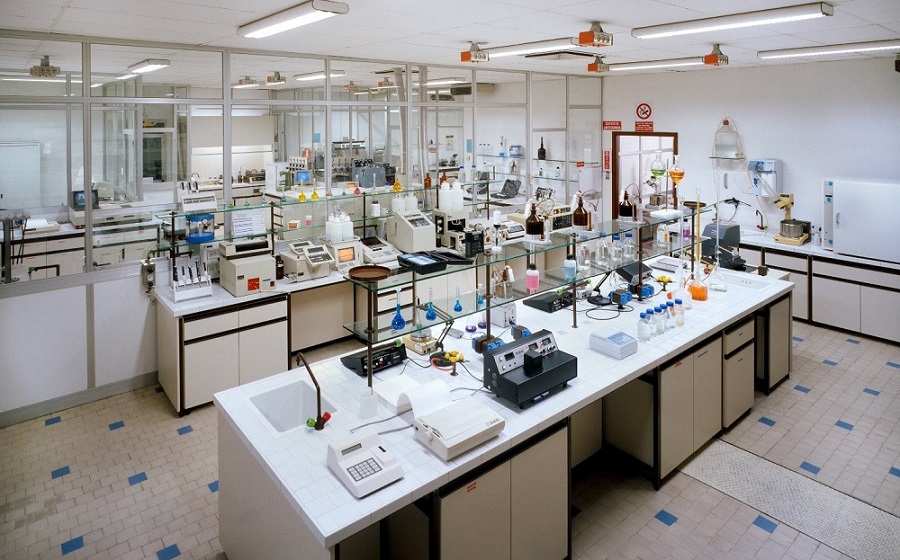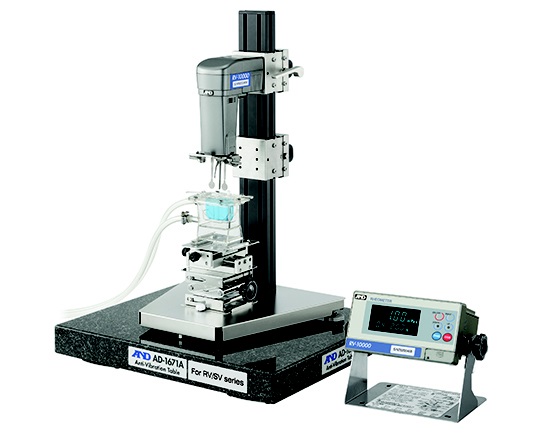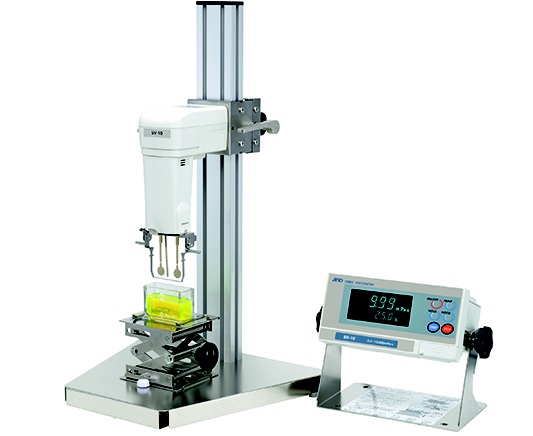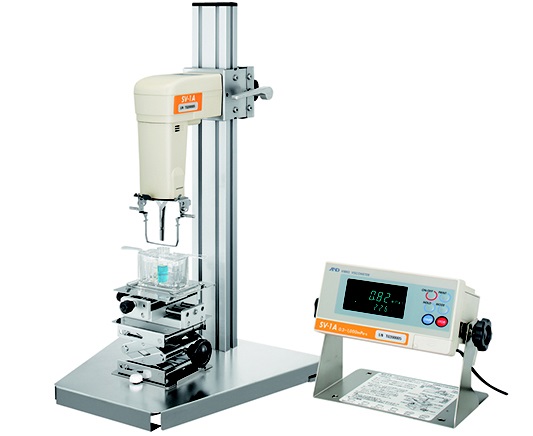A viscometer (viscosimeter) is an instrument used to measure the viscosity of a fluid. A viscometer is a device that is placed into a liquid to determine its viscosity. Viscosity (Cp)= shear stress/shear rate. Viscosity is measured by the resistance levels of liquids in motion when force is applied.

What is viscosity?
Different liquids have varying degrees of thickness that impact their performance and rate. This level of thickness is called viscosity and measuring it is important for a range of reasons.
Viscosity is measured by the resistance levels of liquids in motion when force is applied.
For example, the oil in your car is circulated by your fuel pump. Having an accurate measurement of viscosity is imperative to ensure that the engine oil is being delivered in the correct ratios throughout the motor.
If this viscosity changes, for example, because the oil has become dirty and consequently thicker, it is going to impact the performance of your car engine.
The scientific formula for determining viscosity is shear stress divided by shear rate.
This measurement is expressed in centipoise (cP) which is equal to 1 mPa.s (millipascal second).
Viscosity (Cp)= shear stress/shear rate
At 20 °C, the dynamic viscosity (kinematic viscosity × density) of water is 1.0038 mPa·s and its kinematic viscosity (product of flow time × factor) is 1.0022 mm2/s. These values are used for calibrating certain types of viscometers.
Note: this formula only applies to absolute viscosity. There is a different formula for kinetic viscosity which will be outlined later in this article.
How does a viscometer work?
In general, either the fluid remains stationary and an object moves through it, or the object is stationary and the fluid moves past it.
A viscometer is a device that is placed into a liquid to determine its viscosity. An element is immersed into the fluid where the flow rotates the element and delivers a cP reading. Modern devices can include digital displays and can also deliver readings in a range of different elements. They all operate on similar principles, providing resistance against the flow of the liquid to deliver measurements of viscosity.
What factors can affect viscosity measurements?
Resistance isn’t the only variable when measuring viscosity. Temperature is also important and should be kept at a constant (within 0.02°C of the optimal temperature) throughout the measuring process. The element that is emerged in the liquid needs to have precise dimensions as well because this can deliver variable readings if they are even slightly off.
At 20 °C, the dynamic viscosity (kinematic viscosity × density) of water is 1.0038 mPa·s and its kinematic viscosity (product of flow time × factor) is 1.0022 mm2/s. These values are used for calibrating certain types of viscometers.
What is a rheometer and types of rheometers?
Rheometers are similar to viscometer devices except they can also measure the flow of matter in some solids. Rheology is the umbrella term and viscosity is a sub-category under this umbrella. For liquids with viscosities which vary with flow conditions, an instrument called a rheometer is used. Thus, a rheometer can be considered as a special type of viscometer.
Four different kinds of rheometers can measure viscosity and also other impacts and deformations on properties when force is applied. They include:
- Capillary rheometers: Where the material is pumped through a narrow tube or capillary which eliminates evaporation of the sample.
- Dynamic rotational rheometer: These are capable of measuring viscosity, thixotropy, shear stress, and shear strain. Different varieties include rotating rods in a cup, between a cone and plate, between two plates or between a bob and a cup.
- Torque rheometer: They have proven to be a useful tool for evaluating the behaviour of multi-component thermoplastic systems.
- Oscillatory rheometer: During this measurement, the measuring system moves backward and forward at a specific frequency and amplitude. This test has the advantage of measuring stiff and solid samples by applying small strains to the sample.
Rheometer example: RV-10000A Tuning Fork Vibro Rheometer

Viscometers vs. rheometers
The rheometer measures how fluid flows when force is applied, while the viscometer measures the fluid’s viscosity. Rheometers are used to quantify the rheology of fluids that cannot be described with a single value of viscosity, as opposed to traditional viscometers.
Applications of viscometers and rheometers
Measuring viscosity is important across a wide range of industries including food packaging and preparation, oil and petroleum, paints, inks, beverages, personal care products (shampoos, conditioners, makeup products etc.) adhesives, coatings and more solid materials like plastics, asphalt and more.
Any product that needs to be pumped or piped needs to be measured for its viscosity because any variances or discrepancies can lead to performance and quality issues. Consumers are used to familiarity when it comes to the flow of their products, whether it is the soft drink from their can, toothpaste from the tube or fuel flow into the vehicles. Any changes can lead to dissatisfaction.
When it comes to products such as fuels and oils, coatings, adhesives and materials used in vehicles or constructions sites, discrepancies in viscosity can lead to major product quality issues.
Measuring viscosity is also about determining why the viscosity has changed. It could mean there is abnormal enzyme activity or other factors that can impact the quality and performance of the material. Determining the viscosity of products is vital for engineering packaging, piping and pumping methods to deliver these materials.
Viscometers and rheometers can also be used to determine how the viscosity of a material will change under variable conditions. For example, motor oil will change viscosity as the temperature of an engine increases and this knowledge is vital for the safety and performance of vehicles that it is used in.
Viscosity testing methods
Each method of testing viscosity has its advantages, and there are several established methods. The following is a list of the most widely used testing methods for base oil viscosity:
Using a capillary viscometer
A U-shaped tube, which is commonly referred to as the capillary viscometer, is the main apparatus used in a capillary viscometer test. The U-tube procedure involves submerging the tube in a heated bath (usually between 40 -100 degrees °C) and measuring the time it takes a set amount of liquid to travel from one point in the tube to another by suction or gravity.
To calculate absolute viscosity (suction) or kinematic viscosity (force of gravity), the measured time is multiplied by a constant (associated with the tube).
Testing using a rotating viscometer
With a rotational viscometer, torque is quantified when the spindle is rotated at a constant speed in the liquid sample. The measured torque is proportional to the dynamic viscosity.
The rotational viscometer is a common way to measure non-Newtonian fluid viscosity in chemical and food industries with common applications including:
- Melting tolerance testing for margarine and table spreads.
- Testing the viscosity of confectionery coatings.
- Testing the stability of paints while in storage and during mixing.
- Quality control procedures for food formulations.
- Characterising the sol-gel transition in gelatin.
Viscometer tests with falling balls and falling pistons
Viscometers using falling balls and falling pistons are less common alternatives for measuring viscosity. Tests are performed by allowing a ball or piston to fall into a liquid and measuring the time between one point being marked and another point being marked. Stokes’ law requires knowing the ball’s or piston’s terminal velocity, size and density to calculate the viscosity.
Alternative test methods
Occasionally, the bubble method may be used for oil viscosity testing. The time it takes a bubble to rise a certain distance is measured in this test. Based on these measurements, a proportional relationship can be found between fluid viscosity and measured time. Another variation involves measuring vibration resistance.
Types of viscometers
The basic principle of testing viscosity is fairly simple. Either an object like a rotor or a sphere is moved through the material, or the material is channeled through a stationary device. Both methods will test resistance to flow and deliver viscosity measurements. There are many kinds of devices, but they mostly fall under the umbrella of six different types of viscometers that include:
Capillary viscometers
The capillary viscometer, also known as the u-tube or glass viscometer, is commonly used in laboratories. When a fluid is flowing between two points of a capillary tube, its viscosity is measured by timing how long it takes. The response time of opaque liquids can be hard to determine, so reverse-flow viscometers are necessary, which wet only the timing section of the capillary when the sample has passed the point.
Orifice viscometers
Orifice viscometers are most commonly found in the oil industry. These instruments are made up of an orifice, reservoir and receiver. The viscosity is expressed as efflux time and the measurement is based on measuring the distance between an orifice and the receiver.
Vibrational viscometers
A vibrating viscometer measures viscosity in a process condition with a rugged industrial computer. It has a vibrating rod as the active component. The amplitude of vibration depends on the fluid viscosity. Examples include the SV10-100 Sine-Wave Vibro Viscometer (that is easy to use, provides fast results, and is highly accurate) and the SV-A Series Vibro Viscometer (That only requires a very small sample size that can avoid wastage and reduce expenses).
Falling piston viscometers
They work by drawing liquid into the piston-cylinder as it rises. Using the time taken for the piston to fall due to fluid resistance, the viscosity of the fluid can be measured. Viscometers with falling pistons provide long product life, are simple to use, and require little maintenance.
Rotational viscometers
Rather than measuring volumetric viscosity, rotational viscometers measure torque generated by a spindle rotating in a fluid at a constant speed. Throughout the continuous rotation of the device, fluid analysis can be conducted over time.
Falling ball viscometers
It is based on the measurement principle of Höppler and is a simple but accurate device for measuring the viscosity of transparent Newtonian liquids. A sample-filled tube inclined at an angle is used to measure how long it takes the ball to fall under the pressure of gravity.
Factors that affect viscosity measurements
Like any measurement taken in a controlled environment, many variables can impact the results. It’s important to be aware of these variables so they can be monitored and controlled during the viscosity measurement process. Some of these variables include:
- Temperature: Viscosity is greatly affected by temperature. If you were to compare the same sample at higher and lower temperatures, you would get totally different viscosities. The amount of energy in the sample material will increase as the temperature rises. Increased temperature decreases viscosity since particles interact more quickly (shorter interactions) as they move more quickly, which reduces internal friction or stress.
- The type of glass used in the viscometer: The tubes used in viscometers need to have a precise diameter to deliver accurate outcomes. The tubing needs to be regularly calibrated, at the same temperature that testing will be conducted, to ensure this diameter is at a constant.
- Cleaning: The vessels used to contain or transport the liquid sample must be thoroughly cleaned and rinsed in-between measurements. Even trace elements of a sample can contaminate the next measurement, so this is not a step that can be glossed over.
How do you prepare samples for measurement?
Correct preparation is essential to ensure correct measurements in any laboratory setting. A controlled environment is just as essential when measuring viscosity, so taking the right steps to prepare for the sampling is vital. These preparation steps include:
- Keeping the sample stable: Be careful not to disturb the sample through shaking or stirring, unless there is sediment or separation in which case the tools and methods used to agitate the sample need to be consistent.
- Use the correct methods and tools: For example, applying the sample with a pipette or a syringe is only suitable for materials including oils, solvents and resins.
- Ensure there are no bubbles: This will trigger false results.
- Correct sample sizes: If you use a sample that is too large or too small for the measurement method this will likely mean incorrect results.
- Waiting times: If you are testing a sample multiple times, ensure it has been given the right amount of time to recover from any stress caused to it. Also, ensure you don’t want too long to sample the material, or it may dry out and deliver results that are too high.
Considerations for purchasing viscometers
There are many types and brands of viscometers on the market which can make it challenging to find the right make and model for your requirements.
There is a balance between cost, ease of use and accuracy that all have to be weighed up when choosing any product and that is no different here.
Other considerations should come into play when choosing the right viscometer for your requirements, including:
Viscosity range
As previously mentioned, the measurement of viscosity is pascal seconds (Pa·s). You should look for devices that have the widest range to suit your requirements. For example, SV-10 Sine-Wave Vibro Viscometers can measure low viscosity of 0.3 mPa.s to 10,000 mPas while the SV-100 can measure from 1000mPa.s (cP) to 100,000mPa.s
Accuracy
You want a viscometer that has been engineered and manufactured to deliver the most accurate results possible, but that is not the only consideration. You’ll also want a device that can precisely control temperature and other variables that impact the accuracy of measurements.
For example, SV10-100 Sine-Wave Vibro Viscometers

when you choose the SV series you will have access to a built-in fluid and temperature detection unit that will provide precise temperature levels for accurate sampling.
This temperature control is highly important with certain samples. For example, motor oil changes temperature while in use in an engine. As the temperature of this motor oil rises, the viscosity level decreases. This means you will need a viscometer that is accurate and precise controls for managing the temperature to measure viscosity at the different heat levels it will reach in real-life applications.
Capacity to sample microvolumes and large volumes
You need to ensure the device you choose can handle the volume size of the samples you will be measuring. This does not just mean large volumes; it also means smaller ones. When you need to conduct micro-sampling, you’ll need a device that is capable of measuring these extremely small sample sizes.

A&D Weighing’s SV-A Series can measure sample volumes as small as 2 mL with results within 1 per cent accuracy.
Computer interfacing and automation
A manual viscometer can only be used for one measurement, but automated viscometers can be used for continuous measurements, or to make measurements at multiple temperatures. PCs can be used to interface with some automated instruments.
It is important to determine whether the manufacturer’s software can be integrated with your in-house laboratory system if necessary.
A&D Weighing’s WinCT-Viscometer software displays measurement progress from a Sine-wave Vibro Viscometer in real-time via the RS232C interface. You can save or analyse the measurement results.
Industry standards and regulatory requirements
Make sure that the viscometer you choose is certified according to your industry’s ASTM or ISO standards.

